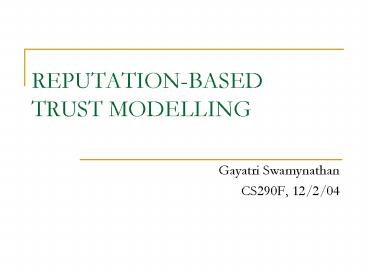REPUTATIONBASED TRUST MODELLING - PowerPoint PPT Presentation
1 / 19
Title:
REPUTATIONBASED TRUST MODELLING
Description:
Performance Metrics. Conclusions and ... Performance Metrics. Mean Time to detect malicious behavior ... Performance Metrics: Detecting Malicious Behavior ... – PowerPoint PPT presentation
Number of Views:34
Avg rating:3.0/5.0
Title: REPUTATIONBASED TRUST MODELLING
1
REPUTATION-BASED TRUST MODELLING
- Gayatri Swamynathan
- CS290F, 12/2/04
2
OUTLINE
- Quick Overview
- Clarifications
- Project Changes
- The Model
- Performance Metrics
- Conclusions and Future Work
3
OVERVIEW
- Trust Management any mechanism that helps
establish trust (or distrust) between peers - Reputation is a measure that is derived from
direct or indirect knowledge of earlier
interactions of peers and is used to access the
level of trust a peer puts into another - Reputation-based Trust Management A Risk
Management Technique
4
Trust The Notion of Context
- Trusting a peer to
- Provide good service (here, files)
- Provide good referrals/opinions
- Malicious (false positives/negatives)
- Incompatible viewpoints
5
Some Project Changes
- Decentralized network (more generic)
- Not just a survey
- Implementing a trust model to understand the
benefits of using reputation
6
OUTLINE
- Quick Overview
- Clarifications
- Project Changes
- The Model
- Performance Metrics
- Conclusions and Future Work
7
The Model File Transfer
Bootstrap File Holders
Random File Requests Generator
2
List of File X Providers
1
3
Peer requests file X
File Transfer
5
Process Trust Values to choose the best peer
Post-Transaction update
4
6
Local Trust Table
8
The Model Representing Trust
- Data Structures to represent Trust
- ServiceTrust (st)
- opinionTrust (op)
- firstHand (fh) to represent direct-interaction
observations - Tolerance Thresholds
- serviceThreshold
- values lower than this indicate untrustworthiness
- If st(i,j) gt serviceThreshold, interact!
- If no serviceTrust value known, trust strangers!
- opinionThreshold
9
The Model Transfer of Trust
- Node i receives fh(k,j) where
- firstHand information on Node j generated by Node
k, post transaction - Case1
- If op(i,k) gt opinionThreshold
- Accept fh(k,j)
- Modify st(i,j)
- Add k to goodOps(j)/badOps(j)
- Case2
- If op(i,k) gt opinionThreshold , but st(i,j)
fh(k,j) - Do NotAccept fh(k,j)
- Modify op(i,k)
10
The Model Transfer of Trust
- Case3
- If op(i,k) lt opinionThreshold
- Do Not Accept fh(k,j)
- Case4
- If op(i,k) lt opinionThreshold , but st(i,j)
fh(k,j) - Accept fh(k,j)
- Modify op(i,k)
- Add k to goodOps/badOps list
- Case5
- No Opinion Values Known trust strangers
opinions!
11
The Model
- But wait
- Node i now interacts with Node j (i.e. st(i,j) gt
serviceThreshold) - If the interaction is bad,
- Node i checks goodOps(j) and reduces
opinionTrust values of all the nodes that gave a
thumbs-up to Node j !!
12
Simulation Setting Topology
- Decentralized Network (10 nodes 25 nodes)
- Stanford GraphBase
- Platform for general graph representation and
manipulation - GT-ITM (Georgia Tech Internetwork Topology Model)
- Creation and analysis of graph models of network
topology - Implementation in NS2 and C
- Peer Agent
- FTP Agent
13
Simulation Setting Sample Topology
- Parameters
- Number of nodes
- Probability of an edge from a node
14
OUTLINE
- Quick Overview
- Clarifications
- Project Changes
- The Model
- Performance Metrics
- Conclusions and Future Work
15
Performance Metrics
- Mean Time to detect malicious behavior
- with and without reputation-based trust model
- different tolerance thresholds
- Overheads
- Storage
- 20 bytes per trust-table entry for a 10-node
network !! - Timestamps?
- Control Messages
- UDP packets
16
Simulation Setting 25-node network
17
Performance Metrics Detecting Malicious Behavior
With and Without Reputation (threshold values
0.5)
18
Performance Metrics Detecting Malicious Behavior
Different Tolerance thresholds (t0.25, t0.5)
19
Conclusions
- Decentralized networks with Reputation-based
trust mechanisms help systems work better. - Future Work
- Post Transaction Analysis of Requesting-Peer
- Collusion
- Reputation-history similar to Credit History































